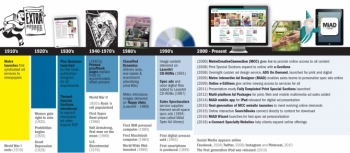
Metro Creative Graphics: Creating Opportunities for Over a Century
If Moses Shapiro, who founded Metro in 1910 with his five sons, found himself in the middle of his company's current headquarters, he would likely say, "I'm glad to see that nothing has changed." While he would be dazzled by the gleaming computers and note the absence of the engraving plates and "ad mats" that held Metro's earliest advertising art, Shapiro would instantly recognize that Metro had stayed true to its mission of providing state-of-the art advertising solutions to its news media partners.
A long list of "firsts"
When Moses Shapiro and his wife Esther arrived in America from Russia, they had no inkling that they would launch an enduring family business that would usher in many "firsts" in retail advertising and newspaper publishing. Their business got off the ground once Moses recognized that his son Jack's illustrations for a prominent New York City menswear retailer could be reproduced and used by newspapers to promote the same clothing brands sold by retailers in other cities. This idea — that advertising art could be syndicated — was the first of many groundbreaking innovations pioneered by Metro.
From day one, Metro has built its success around two key principles: seizing the opportunities that spring from technological advances and creating strong and enduring partnerships with its clients. During the first decades of the 20th century, when all five Shapiro brothers were involved in the business, Metro salespeople took to the road, building enduring relationships with clients and listening to their needs. Based on that feedback, Metro took the concept of syndicated advertising to the next level by introducing specialty services for jewelry, clothing, furniture and department store retailers. After the stock market crash of 1929, when many Americans had to buy goods "on credit," Metro created a specialty "credit" service. During this period, Metro also made the switch from etched printing plates to "mat casting," enabling the company to provide better service to its client companies at a lower cost.
Ongoing innovation
As Metro expanded its presence in the retail and newspaper advertising industries, the Shapiro brothers continued to innovate. In 1937, Metro launched Plus Business, a vehicle for sharing advertising ideas and revenue-building strategies with its clients that is still being published today. The following year, Metro responded to the needs of its clients by introducing the first newspaper special section. These topic-driven sections offered newspapers opportunities to connect with targeted groups of readers while attracting new or additional advertising revenue.
In the 1950s, when offset printing became the most popular form of commercial printing, Metro left "mat casting" behind and produced its first "proof books." The term "clip art" stems from this period, when the production staff of large retailers and newspapers physically clipped desired images from the books to build ads. The range of Metro's images expanded dramatically during the 1950s and 60s to meet the needs of the company's growing client base, which now included newspapers of every size and scope throughout the United States and Canada. In the mid-1960s, Metro introduced its Holiday Advertising Service — a once-a-year collection of winter holiday-themed images, ads and special section covers designed to help newspapers boost their fourth-quarter sales.
Technology opens doors
While Metro's first 50 years focused on expanding its advertising art and ad offerings — first via etched printing plates and ad mats, then in printed "clip art" books — the company's second 50 years reflect both the explosion of technology and its impact on news media and publishing. In the 1980s, when the first IBM and Macintosh personal computers — as well as the World Wide Web — made their debuts, Metro launched Classified Dynamics (now called Campaigns & Classified), which delivered auto, real estate and recruitment advertising images and ads to clients' desks. By 1989, Metro had transferred all of its creative content to floppy disks, making it easier than ever for newspaper production departments to access Metro images and create high-quality ads for their advertisers.
Just two years later, in 1991, Metro swapped its floppy disks for LaserArt CD-ROMs, which offered far greater storage capacity, faster speed and greater durability. Technology was exploding, and Metro made its mark by adding services aimed at boosting ad revenue through the use of spec ads and the addition of color. In addition to adding spec ads and color digital files to its LaserArt CD-ROMs, Metro launched Sales Spectaculars, which supplied themed small-space spec ads and served as the precursor to today's MiAD Spec Ad Library.
Going digital
The turn of the century was a major turning point for Metro. With the launch of MetroCreativeConnection.com — Metro's online gateway to all of its ready-to-use images, spec ads, ideas, photos, logos/trademarks, auto photos and marketing/sales materials — in 2000, Metro subscribers gained instant access to everything they needed to boost advertising revenue.
The transition to an online platform opened the door to a wide range of new opportunities for both Metro and Metro subscribers. Both then and now, any member of a client publication's staff can access and download Metro's content and services using MetroCreativeConnection. The shift to a digital platform coincided with major changes in the media landscape that resulted in the downsizing of staffs at publications across North America. Challenged to maintain revenue levels despite having fewer hands on deck, publishers were in need of creative advertising solutions that could be accessed quickly and easily by multiple members of publications' advertising teams, including sales managers and representatives.
Additions and refinements
Metro responded to those needs with several new offerings, all aimed at harnessing technology to boost ad revenue. By introducing online special sections in 2008, Metro expanded advertising revenue opportunities for client publications. After the introduction of Metro's overnight custom ad design service, ADS On Demand, that same year, Metro users were able to capitalize on every sales opportunity despite time and staffing constraints. The following years saw important additions to Metro's lineup of services and big leaps in creativity and flexibility for publications, including Metro interactive Ad Designer (MiAD), which allows users to create spec ads and finished ads right on screen with only a Web browser and an Internet connection, and ready-to-sell, fully-templated print and digital special sections.
Recent refinements have focused on adding mobile into the mix and making Metro's creative imagery, editorial content and design elements easier to access on the go. Multi-platform Ad Packages for print, Web and mobile were launched in 2012, followed by the MiAD Mobile app for iPad® in 2014. In 2015, MetroCreativeConnection received a complete overhaul to meet the current demands of publishers large and small. The site's Intuitive navigation and innovative search features enable any user to generate everything from ideas to layouts to targeted, presentation-ready ads in minutes—with no time lost on training. The revamp also introduced online, interactive SearchBooks® that connect directly to content for instant downloading.
Some things never change
This year, Metro has already added two new features—MiAD Wizard, which allows sales teams to produce polished, presentation-ready spec ads for print, Web and mobile in a matter of minutes—and e-Connect Specialty Websites—a service designed to help Metro users expand their online offerings through the development of websites for advertisers, special events and more. Future enhancements to Metro's products and services will not only reflect the changing media landscape, but will continue to respond to the specific needs of publishers and their publications. As the publishing industry and technology evolve, so will Metro's services and content. The only thing that will never change is the company's commitment to harnessing technology and forging strong partnerships with client publications.

